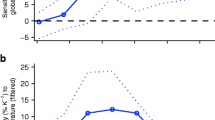Abstract
We present the results of joint analysis of (1) predominant modes of the low-frequency variability of the atmosphere, (2) mechanisms of formation of annual-cycle anomalies, and (3) sudden extreme anomalies on a planetary scale. NCEP/NCAR reanalysis data over 1958–1998 and operational objective analysis of the RF Service for Hydrometeorology and Environmental Monitoring (Rosgidromet) over 2002–2007 with monthly averaging are used. We have attempted to study the cases of extreme monthly mean anomalies in the atmospheric general circulation and their consequences. The role of interannual winter negative anomalies of the air temperature over continents in stabilizing the annual cycle of the present-day climate (which was observed in the 1950s–1960s) is shown, as well as the role of the deformation of the North Atlantic dipole into the planetary wave oriented from west to east (the deformation was observed in April 1997 and again in 2007) in the weakening of the annual climatic cycle.
Similar content being viewed by others
References
J. W. Hurrell and H. Van Loon, “Decadal Variations in Climate Associated with the North Atlantic Oscillation,” Clim. Change 36, 301–326 (1997).
G. P. Kurbatkin, “Dynamics of Climate Transitional Seasons,” Izv. Akad. Nauk, Fiz. Atmos. Okeana 30, 133–144 (1994).
G. P. Kurbatkin, A. I. Degtyarev, E. A. Korotkova, and V. D. Smirnov, “Nature and Structure of Some Anomalies in the Atmospheric Circulation in the Opposite Seasons of the Year,” Russ. J. Numer. Anal. Math. Modeling 18(1) (2003).
A. Niin-Nielsen, and M. Drake., “On the Energy Exchange between the Baroclinic and Barotropic Components of Atmosphere Flow,” Mon. Weather Rev. 93, 79–92 (1965).
J. Namias, “Multiple Causes of the North American Abnormal Winter 1976–77,” Mon. Weather Rev. 106, 279–295 (1978).
R. Kistler, E. Kalnay, W. Collins, et al., “The NCEP/NCAR 50-Year Reanalysis: Monthly Means CD-ROM and Documentation,” Bull. Am. Meteorol. Soc. 82, 247–267 (2001).
H. L. Tanaka and Mio Matsueda, “Analysis of Recent Extreme Events Measured by the Barotropic Component of the Atmosphere,” J. Meteorol. Jpn. 82, 1281–1299 (2004).
Author information
Authors and Affiliations
Corresponding author
Additional information
Original Russian Text © G.P. Kurbatkin, 2008, published in Izvestiya AN. Fizika Atmosfery i Okeana, 2008, Vol. 44, No. 4, pp. 419–434.
Rights and permissions
About this article
Cite this article
Kurbatkin, G.P. Assessment of the half-century evolution of mechanisms controlling the heat exchange between high and midlatitudes in the annual cycle. Izv. Atmos. Ocean. Phys. 44, 387–401 (2008). https://doi.org/10.1134/S0001433808040014
Received:
Accepted:
Published:
Issue Date:
DOI: https://doi.org/10.1134/S0001433808040014




